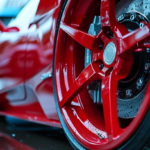If you own a classic car with a vinyl top, chances are that over time it has become worn and damaged. But don’t worry, restoring your vinyl top is easier than you might think. With the right tools and some patience, you can restore your vinyl top to its former glory.
In this guide, we will walk you through the steps of restoring your car’s vinyl top. We’ll cover everything from assessing the damage to preparing the surface for restoration, repairing any underlying structure damage, ensuring proper adhesion and alignment of the new vinyl top, trimming and finishing it off with a protective coating. By following these steps carefully and taking your time throughout the process, you can bring new life to your classic car’s appearance.
Assessing the Damage to Your Vinyl Top
Now it’s time for you to take a closer look at your vinyl top and see just how much damage has been done. Common causes of vinyl top damage include exposure to the sun, rain, and extreme temperatures. If you live in an area with harsh weather conditions or park your car outside without a cover, chances are your vinyl top has suffered some wear and tear over time.
Prevention tips are important to keep in mind as well. To avoid damage to your vinyl top, make sure to park in covered areas whenever possible. Regular cleaning and conditioning of the vinyl can also help extend its lifespan. However, if damage has already occurred, don’t worry – there are steps you can take to restore your car’s appearance.
Gathering the Necessary Supplies and Equipment
First things first, you’ll need to grab all the gear and tools required to get started on bringing your ride’s roof back to life. Choosing appropriate cleaners is essential in ensuring that the cleaning process does not damage your vinyl top. Most vinyl tops are made from either coated or uncoated materials, so it’s crucial to select a cleaner that suits the type of material your car has.
Next, selecting the right type of vinyl material is also crucial when restoring your car’s roof. If you’re unsure about what type of vinyl material your car has, consult with a professional or do some research online before purchasing any restoration products. Once you’ve determined which type of vinyl material you have, it will be easier for you to choose the right restoration product for your project. With these supplies and equipment gathered, you’ll be well on your way to giving your car’s roof a much-needed makeover!
Removing the Old Vinyl Top
It’s time to say goodbye to that worn-out covering and give your ride a fresh new look by peeling off the old vinyl layer! Before you start, make sure you have all the necessary tools such as a heat gun or hair dryer, scraper tool, and safety gloves. Vinyl top removal techniques vary depending on the type of adhesive used during installation. Some tops are glued down with contact cement while others are held in place with clips or screws.
If your car has a glued-on vinyl top, it’s important to take precautions during removal to avoid damaging the underlying surface. Start by heating up the vinyl layer using a heat gun or hair dryer until it becomes soft and pliable. Once heated, use a scraper tool to slowly lift up one corner of the vinyl top and continue working around its perimeter until you can peel off the entire section. Be careful not to apply too much pressure on the scraper tool as this could scratch or dent your car’s exterior finish.
Preparing the Surface for Restoration
Before you get started, you’ll want to make sure your ride is ready for a fresh new look. This means that you need to properly clean and prepare the surface where the new vinyl top will be installed. Cleaning techniques may vary depending on the type of car and condition of the old top, but it’s important to remove any dirt, grime, or adhesive residue from the surface.
To begin preparing the surface for restoration, you should first wash your car thoroughly using soap and water. Then, use a degreaser or adhesive remover to get rid of any sticky residue left behind by the old vinyl top. After this step, use sandpaper or a wire brush to smooth out any rough spots or rusted areas on the surface. Remember that proper surface preparation is key in ensuring that your new vinyl top adheres securely and lasts long.
Repairing Any Damage to the Underlying Structure
Now that you’ve cleaned the surface, it’s time to check for any damage to the underlying structure and fix it up before installing your new ride’s fresh look. If there are any rust spots or dents on the metal frame underneath your vinyl top, they need to be repaired before proceeding with restoration. Structural repair is a crucial step in ensuring that your car looks great and stays safe for years to come.
You can either choose to do this yourself or hire a professional for structural repairs. DIY is an excellent option if you have experience working with cars and know what you’re doing. However, if you’re not confident in your skills, it’s best to leave it to professionals who have the right tools and expertise. It may cost more upfront, but investing in quality repairs will save you money in the long run by preventing potential accidents caused by faulty workmanship.
Applying a New Layer of Vinyl Material
To give your ride a fresh new look, you’ll need to select the right vinyl material for your car’s exterior. There are different types of vinyl materials available in the market, each with varying levels of durability and quality. It’s essential to choose a high-quality vinyl that can withstand harsh weather conditions, UV radiation, and other external factors that could potentially damage it.
Once you’ve selected your preferred vinyl material, you have two installation options: DIY or professional installation. If you’re confident in your skills and experience in car restoration projects, then DIY may be an option for you. However, if you want to ensure that the job is done correctly and without any complications, consider hiring a professional installer. Professional installers have the tools and expertise necessary to do the job efficiently while ensuring that there are no errors or damages made during the process. Ultimately, selecting the right vinyl material and installation method can make all the difference in achieving a successful car vinyl top restoration project.
Ensuring Proper Adhesion and Alignment
Achieving a flawless and long-lasting vinyl installation requires proper adhesion and alignment, which can be accomplished with attention to detail and precision during the process. Before starting the installation, ensure that the surface of your car’s roof is clean and free of any debris or contaminants. Proper cleaning is necessary as any dirt or dust left on the surface can cause bubbles or wrinkles in the vinyl material.
Once you have cleaned the surface, use a heat gun to soften up both the vinyl material and the adhesive back. This will make it easier for you to manipulate them into place while ensuring that they adhere properly. Be sure to keep a safe distance from your car while using the heat gun and move it continuously to avoid overheating any one area. With these two simple techniques- proper cleaning and heat gun application- you can achieve excellent results in terms of adhesion and alignment when installing a new layer of vinyl material onto your car’s roof.
Trimming and Finishing the New Vinyl Top
After ensuring proper adhesion and alignment, it’s time to trim and finish the new vinyl roof for a seamless look. Trimming techniques depend on the type of vinyl top you have installed. For example, if it is a full vinyl roof that covers the entire body of your car, you will need to trim around the edges using sharp scissors or a utility knife. Be sure to cut along the edge of the molding or trim piece to ensure a clean line.
Finishing options for your vinyl top include adding decorative moldings or chrome strips along the edges. This can give your car a classic, vintage look. You can also opt for a more modern finish by choosing a sleeker design without any added embellishment. Whatever finishing option you choose, be sure to inspect your work carefully before driving off with your newly restored car. Any rough edges or misaligned seams can detract from the overall appearance of your vehicle and may even cause damage over time if left unattended.
Applying a Protective Coating
Now it’s time for you to apply a protective coating to your newly installed vinyl roof. Choosing the right coating is crucial in ensuring that your vinyl top lasts longer and stays protected from environmental damage. You can choose from a variety of coatings available in the market, including acrylic, silicone, and wax-based coatings. Acrylic coatings offer better protection against UV rays while silicone coatings are great for repelling water. Wax-based coatings provide excellent shine and durability.
Once you have chosen the right coating, it’s time to apply it using buffing techniques. Start by cleaning the surface with a mild soap and water solution. Dry it off completely before applying the coating. Use a microfiber cloth or foam applicator pad to apply the coating on small sections at a time, working from one end of the roof to another. Buff each section until you achieve an even finish without any streaks or smudges. Allow it to dry completely before taking your car out on the road again. With these simple steps, you can ensure that your vinyl top remains protected and looking new for years to come!
Maintaining Your Restored Vinyl Top for Longevity
To ensure your newly coated vinyl roof stays protected and looking great, you’ll want to take some simple steps. First, make sure to clean your vinyl top regularly. This will prevent any debris or dirt from building up and potentially causing damage. Use a soft-bristled brush and mild soap to gently scrub the surface of the vinyl top. Avoid using harsh chemicals or abrasive materials that could scratch or peel off the protective coating.
Secondly, use the best cleaning products for your restored vinyl top. Look for cleaners specifically designed for vinyl tops that won’t strip away the protective coating. Apply them according to the manufacturer’s instructions, being careful not to oversaturate the surface with too much product. Regular maintenance will keep your vinyl top in excellent condition for years to come, protecting it from UV rays, moisture, and other environmental factors that can cause damage over time.
Conclusion
Congratulations! You have successfully restored your car’s vinyl top to its former glory. By following the steps outlined in this guide, you have not only improved the appearance of your vehicle but also ensured its longevity.
Remember to maintain your newly restored vinyl top by regularly cleaning it with a soft cloth and mild soap. Avoid using harsh chemicals or abrasive tools that could damage the surface. With proper care, your vinyl top should continue to provide protection and style for many years to come. Enjoy cruising in your refreshed ride!

Lucas is an experienced vehicle technician with hands-on knowledge of almost every car brand available. Throughout his career, Lucas has worked on a wide range of vehicles, including domestic and foreign models, sports cars, trucks, and SUVs.





